A new installation brings playful and thought-provoking public art to the Science and Engineering Quad
The dynamic spheres created by international artist Alicja Kwade suggest alternate realities.
Twelve dazzling stone spheres, ranging in size from a diminutive 16 inches to a colossal 98 inches, are a surprising and provocative addition to the Science and Engineering Quad. International artist Alicja Kwade created the site-specific outdoor work, titled Pars pro Toto, which was installed earlier this month.
Go to the web site to view the video.
Sited between the octagonal Jen-Hsun Huang Engineering Center at one end of the quad and a double row of poker-straight palm trees on the other end, the spheres of stones sourced from eight different countries give the quad the feeling of a giant play space scattered with marbles, pick-up-sticks and building blocks. In fact, the artist determined the positioning of the stones by throwing tiny spheres onto a model of the quad to see where they would land.
The highly collaborative process of selecting the work was launched by Jennifer Widom, the Frederick Emmons Terman Dean of the School of Engineering, who asked Laura Breyfogle, then the School of Engineering’s senior associate dean for external relations, to establish an ad hoc committee of faculty, staff and students from throughout the university to select the artwork. Like other recent public art projects on campus that have been underwritten by private donors, Pars pro Toto was funded by a Stanford alumni family who are long-loyal supporters of the university.
“I’m thrilled that we’ve been able to bring Pars pro Toto to Stanford, and I’m truly grateful to the many people who helped make this exciting project a reality,” said Widom. “As students, faculty, staff and visitors return to campus over the coming months, they’re going to find a Science and Engineering Quad that’s been transformed.
“One of the things I find particularly exciting about this work is how it inspires each person to bring to it their own interpretation, their own way of interacting with it. I greatly look forward to walking through the SEQ every day, watching people approach and enjoy our wonderful new art piece.”
Altering the Stanford landscape
Matthew Tiews, interim senior associate vice president for the arts, associate vice president for campus engagement and chair of the university’s Public Art Committee, which helped support this project, said he is excited about Pars pro Toto’s connections to science and the natural world. In particular, he said, he was pleased to see the deep engagement with geology that has come forward from Donald R. Lowe, the Max Steineke Professor in Earth Sciences at the School of Earth, Energy & Environmental Sciences. “The artwork animates the entire SEQ, which looks and feels very different than the one we remember from before the pandemic,” said Tiews.
Sophia Pink, BS ’19, MS ’20, who was a student member of the artwork selection committee, said of Pars pro Toto: “I love this piece because it breaks us out of our day-to-day preoccupations. It reminds us that we’re a small part of a large world, and that randomness plays a part in everything.”
Ann Tanaka, BS ’19, another member of the selection committee that chose Pars pro Toto, believes in the importance of bringing art into the SEQ. “The Stanford arts map shows public art distributed relatively evenly across campus, except for the Science and Engineering Quad,” she said. “Art and engineering aren’t inherently disparate disciplines. Both are highly creative and often driven by curiosity, so the two don’t have to be segmented off to separate corners of campus, physically and intellectually. I hope that the opportunity for Stanford engineers to interact and engage with beautiful artwork on the way to class or lab sparks dialogue or inspires new ideas and thinking.”
The Science and Engineering Quad is located in Stanford’s Academic Campus Zone, which is currently restricted to students, faculty, staff and postdoctoral scholars approved to be on campus. The zones program is temporary and the university looks forward to lifting restrictions in accordance with state and local public health orders as pandemic conditions improve.
Space, time, science and philosophy
Alicja Kwade was born in 1979 in what was then communist Poland and escaped with her family to West Germany when she was 8 years old. Kwade went on to study at the Berlin University of the Arts. Her experience on both sides of the Berlin Wall deeply informs her investigations into the structures of our reality and the role of perception in society. Her diverse practice is based around concepts of space, time, science and philosophy, and takes shape in sculptural objects, public installations, video and photography.
Kwade’s work has been exhibited nationally and internationally, including at the Metropolitan Museum of Art, New York; the Venice Biennale; The Bass museum of contemporary art in Miami; MIT List Visual Arts Center, Cambridge; Yuz Museum Shanghai; and Whitechapel Gallery, London.
Reflecting on the creation of Pars pro Toto for the Stanford campus, and specifically for the Science and Engineering Quad, Kwade said, “The work is a threefold reflection: It allows us to become giants roaming a human-scale solar system, but it also reminds us to be dwarfed by the ever-expanding universe. We become aware that our Earth is but a minute sphere, a marble suspended in our geocentric horizon. Right here, right now on campus we reflect these opposing realities through the experience of Pars pro Toto.”
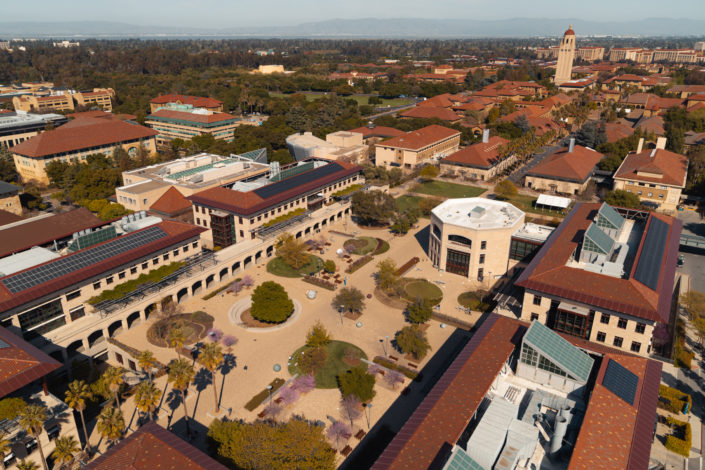
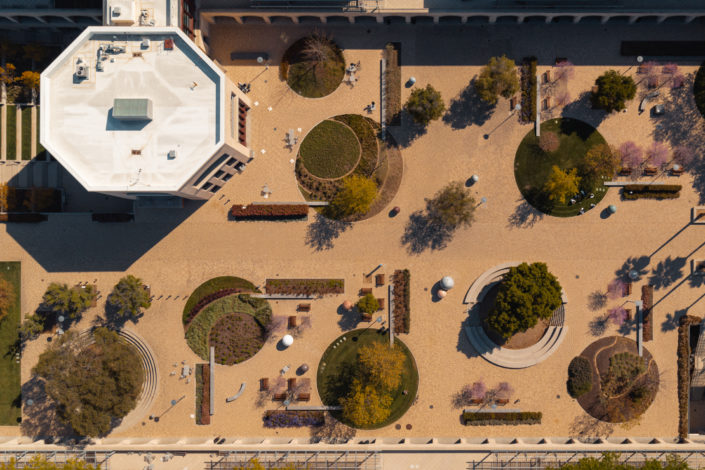
Alicja Kwade: Artist statement
Pars pro Toto, 2021, reaches for the cosmos while staying grounded in the geological history of our planet.
Twelve stone globes scattered across the quad resemble a galaxy of small planets, as if the cosmos had been laid down at our feet. Each stone represents a self-contained world or universe, drawing on the many-worlds interpretation of quantum mechanics, which suggests that all possible alternate histories and futures are real.
The positioning of the globes was determined by chance: The artist threw tiny spheres onto a model of the Stanford Science and Engineering Quad to dictate placement. This gesture implies a higher being playing marbles with these planet-like spheres, creating a new universe. The arrangement also references billiard breaks, a real-world action used to visualize quantum analogues.
The natural stones come from three different continents of our Earth. The material of the stone itself, with layers that have formed over billions of years, acts as a kind of timescale. Each corner of the world and layer of Earth yields a multitude of stone varieties, colors and textures so that no two stones are alike. True to the meaning of the Latin phrase pars pro toto – “a part for the whole” – the stones individually and collectively evoke the micro and macro scales of our existence.

Alicja Kwade (Image credit: Christian Werner)
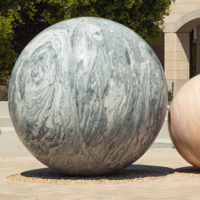
VISCONTE WHITE, India
Visconte White is part of an assemblage of rocks that forms much of the upper continental crust of southern India. It is a type of complex, layered metamorphic rock termed gneiss formed by the heating and squeezing (deformation) of older rocks. The Visconte White gneiss includes light bands that were originally formed by the cooling and crystallization of liquid magmas. These are interlayered with darker, more iron- and magnesium-rich bands representing volcanic materials or sedimentary rocks that were invaded by the liquids. These original rocks have been heated, deformed, and folded and refolded in a taffy-like fashion until the components now occur as thin light or dark bands with little or no remaining features of the original rocks. These gneisses were formed 3.0 to 2.5 billion years ago when a stack of Hawaii-like dark volcanic rocks was buried and then invaded by quartz and feldspar-bearing magmas, similar to the granites in the modern Sierra Nevada in California. This assemblage of rocks was deformed and metamorphosed multiple times to form the complex rock that we see today.

CARRARA, Italy
The lovely Carrara Marble, said to be Michelangelo’s favorite and the stone out of which he carved David and the Pietà, comes from the small town of Carrara, near the west coast of northern Italy. The hills east of Carrara are steep and covered with quarries from which blocks of the famous marble are cut. Carrara Marble is renowned as a building stone because it is so pure, uniformly white, and can be quarried in very large blocks. The Carrara Marble started out as fine lime mud and sand made up of the shells of marine organisms deposited on the bottom of quiet, protected lagoons and tidal flats. These were part of a broad, shallow-marine carbonate sea that covered the northern part of what is now Italy 200 million years ago. As these sediments accumulated, they were buried and cemented to form limestone. This stack of sedimentary rocks was deformed and metamorphosed as small tectonic plates collided about 25 million years ago. The Carrara Marble outcrops that we see today are seen through a geologic “window” in a sheet of younger, unmetamorphosed rock that was thrust up and over the older marbles and related sediments.
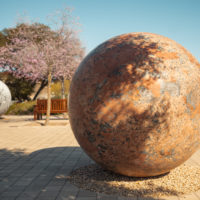
ALASKA RED, India
Alaska Red is an igneous rock formed by the crystallization of molten rock or magma. It is quarried from an unusual body of rock called a pegmatite characterized by very large mineral grains; in this case, gray quartz and pink feldspar with crystals that reach up to 1 meter long. Pegmatites form late in the history of a body of magma. As the magma cools and crystallizes, generally several kilometers below Earth’s surface, dissolved water and other volatiles become concentrated in the remaining liquid and eventually begin to escape by rushing up cracks and fractures in the surrounding rock. Dissolved components carried by the escaping superheated water and magma are precipitated along the sides of the conduits as large crystals. Some crystals in pegmatites can reach tens of meters across. This pegmatite is part of a younger generation of igneous rocks formed 800 to 700 million years ago in Rajasthan, northwestern India.
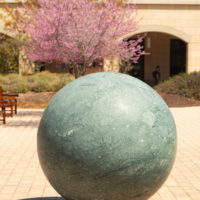
VERDE GUATEMALA, India
Verde Guatemala, or so-called “Green Marble,” is actually neither from Guatemala nor a marble. The sphere in this artwork came from quarries in Rajasthan, India, and formed not as sediments on the sea floor, the starting point for most marble, but through the alteration of an igneous rock formed by the cooling and crystallization of iron and magnesium-rich magma. These magmas were erupted and crystallized 2.5 billion years ago as part of a widespread oceanic crust, or they may have crystallized below the oceanic crust within the upper part of Earth’s mantle. In the area of southern Rajasthan, small bodies of these rocks have been squeezed up into a younger, 2.5 to 1.9 billion-year-old sedimentary sequence. The original igneous materials have been altered to dark greenish minerals of the serpentine group to form a rock called serpentinite. Much of the rock has been intensely broken and shattered during alteration and tectonic movements, as can be seen from the fragmental character of the rock making up Sphere 4. Much younger serpentinite is so widespread in western California that it has been designated as the California state rock.
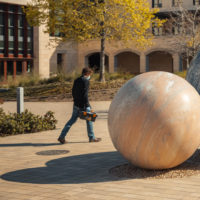
ROSA PORTOGALLO, Portugal
Rosa Portogallo is a lovely pale pink marble cut by dark gray to black veins. It was deposited about 500 million years ago as soft sediments composed of the shells of ancient organisms that lived in a shallow sea in what is today eastern Portugal. The limestones were interlayered with volcanic rocks formed during the stretching and extension of the continental crust across what is today western Europe. This stretching ultimately led to the formation of an ancient ocean, the Rheic Ocean, roughly coincident with the modern Atlantic Ocean. After deposition and burial beneath other sediments, the limestones were deformed, heated and metamorphosed to marble about 320 million years ago when the ancient Rheic Ocean closed and there was a collision between the future North American and European continental blocks.
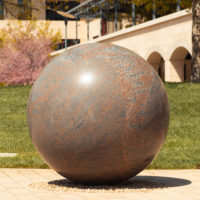
HALMSTAD, Sweden
The Halmstad or Hallandia Gneiss outcrops in southwestern-most Sweden. It is a metamorphic rock composed of fine, intensely folded and deformed dark bands that have suffered multiple episodes of deformation and lighter pinkish patches and layers that represent granitic liquid injected into the darker material. The original rocks were granites formed by the cooling of large bodies of magma many kilometers below Earth’s surface 1.7 to 1.6 billion years ago. These rocks were heated, deformed and invaded by younger magmas during widespread continent collision, metamorphism and mountain building 1.5 to 1.0 billion years ago. Today, the rocks are exposed over a small area where commercial quarrying often competes with recreation and other potential land uses.
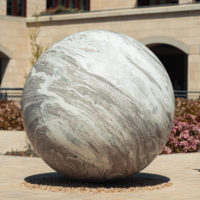
FANTASY BROWN, India
The Fantasy Brown marble is one of the most controversial stones in this display because of the many names and diverse origins assigned to this rock type. It has been called Fantasy Brown granite (a rock formed by cooling of a magma), Fantasy Brown quartzite (a rock formed by the alteration of sedimentary sandstone at high temperature and pressure) and Fantasy Brown marble (a sedimentary limestone that has been altered at high temperature). The Fantasy Brown in Sphere 7 comes from quarries near the town of Paloda, Rajasthan, India, and is probably 2.5 to 1.9 billion years old. It is composed of complexly interfingering and interlayered bands of quartz-rich sedimentary rock (quartz sandstone) and calcium carbonate-rich sedimentary rock (limestone) that were deposited into a shallow sea developed across this part of India at that time. The sediments were later heated and deformed under high pressures and temperatures to form the rock you see today. Hence, it started out as a sedimentary rock and has been converted with burial and tectonic stresses into a metamorphic rock.

MASI, Norway
The Masi Quartzite is a rich green, complex rock characterized by thin, often tightly folded and twisted layers that vary from deep green to light green to nearly white. The color in the dark green layers is from a chromium-rich mineral called fuchsite and the lighter layers contain abundant quartz. The rock tends to split along the darker layers, and cutting large, coherent, unfractured blocks is difficult. The rock is quarried near a small town, Masi, in northern Norway, where quarrying is restricted to just part of the year because the quarries lie close to or within a reindeer reserve. These rocks are part of a thick metamorphosed sedimentary unit formed by deposition of sand in what was probably a shallow sea around 2.5 to 2.2 billion years ago. The original chromium-rich mineral was likely eroded from volcanic rocks and deposited as detrital grains along with the quartz. The quartz and chromium-rich grains were later buried, metamorphosed and deformed to produce the rocks seen today.

RED FIRE, India
Red Fire is a well-layered sedimentary rock composed of fine-grained, deep rusty red muddy layers interbedded with lighter colored lumpy and discontinuous sandy and silty layers. It is a lovely sedimentary rock formed about 750 to 700 million years ago in northwestern India. This was a time of global glaciation and formation of these layers may have been influenced by cold-climate events.
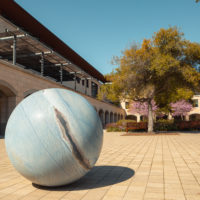
MACAUBAS, Brazil
Macaubas or Macaubas Blue is a striking blue quartzite from eastern Brazil. The quartzite formed by the heating and deformation of a unit of sandstone composed of a mixture of quartz grains and other minerals that altered to give the lovely blue color. These original minerals were eroded from older rocks in highlands that surrounded the Macaubas Basin and were mixed with quartz grains in shallow marine environments that characterized the basin between 1.5 and 0.7 billion years ago. The blue color reflects the presence of the mineral lazulite, a blue iron, magnesium and aluminum phosphate mineral formed during metamorphism of the sequence about 635 million years ago.

AMADEUS, Finland
The patchy dark and light rock of Sphere 11 is a stone termed Amadeus from Finland. The rock is a granite, an igneous rock that crystallized from a magma well below Earth’s surface. Amadeus is distinguished by the presence of large, dime- to quarter-sized pink garnets within a matrix of banded dark and light materials. About 1.9 to 1.8 billion years ago, volcanic and sedimentary rocks in what is now southeastern Finland were deformed and uplifted to form a belt of mountains and were invaded by large bodies of granitic magma. This magma formed in part by melting of sedimentary rocks, including shales and mudstone, and the addition of these sedimentary components to the magma provided compositional elements that enabled garnet to form during crystallization.
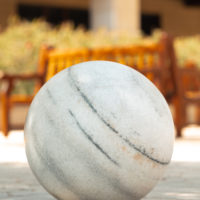
MUGLA, Turkey
Mugla Marble is a homogeneous, fine-grained white marble from southwestern Turkey. It has been recognized as a source of marble for many classical Greek and Roman sculptures, especially in the eastern Mediterranean region, although distinguishing it from other fine marbles, such as the Carrara Marble from Italy (Sphere 2), is difficult. Chemical tests have provided some of the best means of recognizing the marble varieties represented by ancient sculptures, statuary and artifacts. There is also a black variety of Mugla Marble that contains fine, black carbonaceous matter representing the remains of ancient organisms. The Mugla Marble formed about 200 to 100 million years ago (Jurassic-Cretaceous) as limestone deposits on the bed of a shallow sea that covered much of the eastern Mediterranean region. The deposits were buried and later deformed and heated to form marble. In younger geologic time, they were uplifted to form the mountains that characterize most of western Turkey today.

